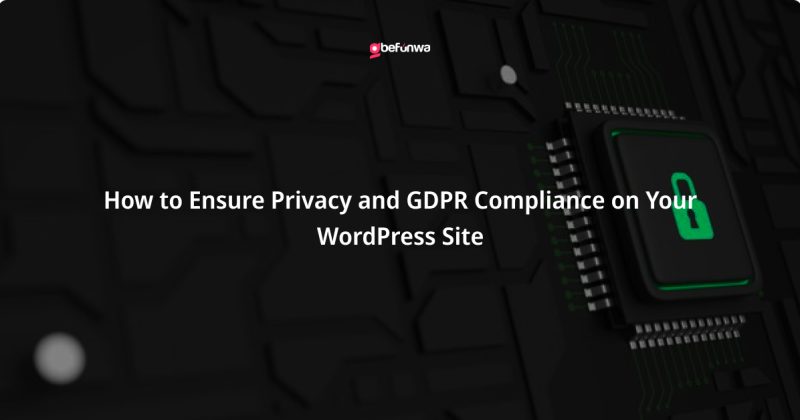
Privacy and data protection have become increasingly important considerations for website owners. With the implementation of regulations such as the General Data Protection Regulation (GDPR), ensuring compliance and protecting user privacy has become a top priority. In this comprehensive guide, we’ll explore the essential steps to safeguarding your WordPress site and maintaining GDPR compliance.
The General Data Protection Regulation (GDPR) is a comprehensive data privacy law enacted by the European Union (EU) to protect the personal data of individuals within the EU and European Economic Area (EEA). GDPR applies to all businesses and websites that collect, process, or store personal data of EU citizens, regardless of their location.
Start by conducting a thorough privacy audit of your WordPress site to identify areas where personal data is collected and processed. This includes forms, comments, user registrations, contact forms, analytics tools, and third-party plugins. Document all data processing activities and assess their compliance with GDPR requirements.
Create and publish a comprehensive privacy policy on your WordPress site that clearly outlines how you collect, use, and protect personal data. Your privacy policy should include details such as the types of data collected, purposes of processing, data retention periods, and information about users’ rights under GDPR. Ensure that your privacy policy is easily accessible and prominently displayed on your website.
Under GDPR, obtaining explicit consent from users before collecting their personal data is mandatory. Implement cookie consent banners and opt-in checkboxes on your WordPress site to obtain consent for data processing activities such as cookies, analytics tracking, and marketing communications. Clearly explain the purpose of data collection and provide users with the option to opt out if desired.
Encrypt data transmission between your WordPress site and users’ browsers using Secure Sockets Layer (SSL) certificates. SSL encryption helps protect sensitive information such as login credentials, payment details, and personal data from interception by unauthorized parties. Install an SSL certificate on your web server and configure your WordPress site to use HTTPS protocol for secure data transfer.
Minimize the collection of personal data on your WordPress site to only what is necessary for the intended purpose. Avoid collecting sensitive information unless absolutely required, and limit the retention period of collected data to comply with GDPR’s data minimization principle. Regularly review and delete outdated or unnecessary data to reduce the risk of data breaches and ensure compliance with GDPR’s data storage limitation.
Implement robust security measures to protect personal data stored on your WordPress site from unauthorized access, misuse, or loss. This includes regularly updating WordPress core, themes, and plugins to patch security vulnerabilities, implementing strong password policies, and using security plugins to monitor and mitigate security threats. Additionally, consider implementing measures such as encryption, access controls, and regular backups to safeguard data integrity and confidentiality.
GDPR grants users several rights regarding their personal data, including the right to access, rectify, and delete their data. Ensure that your WordPress site allows users to exercise these rights easily by providing clear mechanisms for data subject requests. Implement user account management features, data access portals, and contact forms to facilitate user requests and demonstrate compliance with GDPR requirements.
Regularly review and audit your WordPress site’s privacy practices to ensure ongoing compliance with GDPR requirements. Conduct internal audits to assess data processing activities, update privacy policies, and review data protection measures. Additionally, consider engaging third-party auditors or consultants to perform independent assessments and provide recommendations for improvement.
Ensuring privacy and GDPR compliance on your WordPress site is essential for building trust with your users and avoiding potential legal consequences. By following the steps outlined in this guide, you can establish a solid foundation for protecting user privacy, maintaining GDPR compliance, and mitigating the risk of data breaches. Take proactive measures to safeguard personal data, implement privacy policies, obtain explicit consent, and regularly audit your site’s privacy practices to stay ahead of evolving regulatory requirements. With a commitment to privacy and data protection, you can create a safe and secure online environment for your users and build a reputation as a trustworthy website owner.
Deborah Oludimu is an experienced content writer with 3+ years of experience. She is skilled in research, writing, and editing to produce high-quality, engaging content across industries. Deborah is passionate about creating content that informs and inspires
© 2025 GBEFUNWA.COM. All rights reserved.
The WordPress® trademarks are the intellectual property of the WordPress Foundation, and the Woo® and WooCommerce® trademarks are the intellectual property of WooCommerce, Inc. Uses of the WordPress®, Woo®, and WooCommerce® names in this website are for identification purposes only and do not imply an endorsement by WordPress Foundation or WooCommerce, Inc. gbefunwa is not endorsed or owned by, or affiliated with, the WordPress Foundation or WooCommerce, Inc.